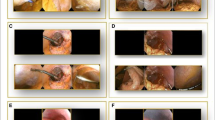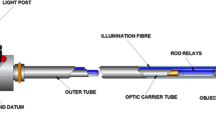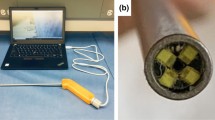Abstract
Background
“Tunnel vision” associated with endoscopes used in NOTES and laparoscopes used in laparoendoscopic single-site surgery (LESS) procedures present the surgeon with a disorienting view of familiar surroundings. Given the in-line arrangement of the devices, it is difficult to achieve adequate triangulation, a critical component of successful surgical technique. A potentially more useful vantage point would be from above, looking down at the surgical field, i.e., “stadium view.” The purpose of this study was to develop stadium-view camera prototypes for evaluation.
Methods
Cylindrical (15 mm diameter, 30 mm length) imagers were built using white light LEDs for illumination and a near-VGA resolution CMOS camera. These prototypes were delivered to the abdominal cavity through an overtube (Steerable Flex Trocar (SFT)); the electronic tether for power and video signal was pulled through the abdominal wall using a 2-mm rigid grasper. The prototypes were attracted to the abdominal wall magnetically. Clinicians performed the procedures in IACUC/Home Office-approved porcine labs.
Results
Introduction of the device into the peritoneal cavity and magnetic coupling to the abdominal wall were straightforward. Illumination was adequate to provide reasonable imagery of nearby abdominal organs. Bowel was successfully sutured laparoscopically under visualization provided by the prototype. All points on the abdominal wall could be reached via the magnetic control, and the camera could be successfully aimed through abdominal palpation. Retrieval was uncomplicated.
Conclusions
The prototypes provide the clinician a point of view similar to that of a traditional laparoscope, although the image quality needs improvement. The stadium view helps to overcome limitations associated with in-line visualization and working tools. Use of such a camera in NOTES or LESS could enable reduction of the number/size of ancillary trocars, reduce the size of the LESS port, and/or increase the number of working devices that can be deployed.






Similar content being viewed by others
References
Kalloo AN, Singh VK, Jagannath SB, Niiyama H, Hill SL, Vaughn CA, Magee CA, Kantsevoy SV (2004) Flexible transgastric peritoneoscopy: a novel approach to diagnostic and therapeutic interventions in the peritoneal cavity. Gastrointest Endosc 60:114–117
Hazey JW, Narula VK, Renton DB, Reavis KM, Paul CM, Hinshaw KE, Muscarella P, Ellison EC, Melvin WS (2008) Natural-orifice transgastric endoscopic peritoneoscopy in humans: initial clinical trial. Surg Endosc 22:16–20
Bernhardt J, Gerber B, Schober HC, Kähler G, Ludwig K (2008) NOTES—case report of a unidirectional flexible appendectomy. Int J Colorectal Dis 23:547–550
Palanivelu C, Rajan PS, Rangarajan M, Parthasarathi R, Senthilnathan P, Prasad M (2008) Transvaginal endoscopic appendectomy in humans: a unique approach to NOTES—world’s first report. Surg Endosc 22:1343–1347
Marescaux J, Dallemagne B, Perretta S, Wattiez A, Mutter D, Coumaros D (2007) Surgery without scars: report of transluminal cholecystectomy in a human being. Arch Surg 142:823–826
Zorron R, Maggioni LC, Pombo L, Oliveira AL, Carvalho GL, Filgueiras M (2008) NOTES transvaginal cholecystectomy: preliminary clinical application. Surg Endosc 22:542–547
Auyang ED, Hungness ES, Vaziri K, Martin JA, Soper NJ (2009) Human NOTES cholecystectomy: transgastric hybrid technique. J Gastrointest Surg. doi:10.1007/s11605-009-0813-y, Feb 7, 2009
Ramos AC, Zundel N, Neto MG, Maalouf M (2008) Human hybrid NOTES transvaginal sleeve gastrectomy: initial experience. Surg Obes Relat Dis 4:660–663
Gumbs AA, Milone L, Sinha P, Bessler M (2009) Totally transumbilical laparoscopic cholecystectomy. J Gastrointest Surg 13:533–534
Piskun G, Rajpal S (1999) Transumbilical laparoscopic cholecystectomy utilizes no incisions outside the umbilicus. J Laparoendosc Adv Surg Tech A 9:361–364
Inoue H, Takeshita K, Endo M (1994) Single-port laparoscopy assisted appendectomy under local pneumoperitoneum condition. Surg Endosc 8:714–716
Rao MM, Rao RK (2004) Two-port and single port laparoscopic appendicectomy. J Indian Med Assoc 102:360, 362, 364
Castellucci SA, Curcillo PG, Ginsberg PC, Saba SC, Jaffe JS, Harmon JD (2008) Single port access adrenalectomy. J Endourol 22:1573–1576
Bucher P, Pugin F, Morel P (2008) Single port access laparoscopic right hemicolectomy. Int J Colorectal Dis 23:1013–1016
Nguyen NT, Hinojosa MW, Smith BR, Reavis KM (2008) Single laparoscopic incision transabdominal (SLIT) surgery-adjustable gastric banding: a novel minimally invasive surgical approach. Obes Surg 18:1628–1631
Aron M, Canes D, Desai MM, Haber GP, Kaouk JH, Gill IS (2009) Transumbilical single-port laparoscopic partial nephrectomy. BJU Int 103:516–521
Kaouk JH, Goel RK, Haber GP, Crouzet S, Desai MM, Gill IS (2008) Single-port laparoscopic radical prostatectomy. Urology 72:1190–1193
Kommu SS, Rané A (2009) Devices for laparoendoscopic single-site surgery in urology. Expert Rev Med Devices 6:95–103
Rattner D, Kalloo A, ASGE/SAGES Working Group (2005) ASGE/SAGES working group on natural orifice translumenal endoscopic surgery. Surg Endosc 20(October):329–333
Swanstrom L, Zheng B (2008) Spatial orientation and off-axis challenges for NOTES. Gastrointest Endosc Clin N Am 18:315–324
Carswell CM, Clarke D, Seales WB (2005) Assessing mental workload during laparoscopic surgery. Surg Innov 12:80–90
Raman JD, Scott DJ, Cadeddu JA (2009) Role of magnetic anchors during laparoendoscopic single site surgery and NOTES. J Endourol 23(5):781–786
Acknowledgments
The authors thank Dave Plescia (EES), Optimum Technologies, Inc., and the preclinical staffs at the Royal Veterinary College, London, UK, and Ethicon Endo-Surgery Institute, Cincinnati, Ohio for their support in this study.
Disclaimer
The tethered, independent, cameras, 2-mm trocars, Rotating Access Needle and Steerable Flex Trocar used in this study are not yet approved by the FDA for use in humans.
Disclosures
Drs. C. Paul Swain and Ralph Austin are consultants for Ethicon Endo-Surgery. Robert Trusty and Kurt Bally are employees of Ethicon Endo-Surgery.
Author information
Authors and Affiliations
Corresponding author
Rights and permissions
About this article
Cite this article
Swain, P., Austin, R., Bally, K. et al. Development and testing of a tethered, independent camera for NOTES and single-site laparoscopic procedures. Surg Endosc 24, 2013–2021 (2010). https://doi.org/10.1007/s00464-010-0897-1
Received:
Accepted:
Published:
Issue Date:
DOI: https://doi.org/10.1007/s00464-010-0897-1




